Technology
Top 5 Naruto Characters Who’d Be Tech Geniuses Today
Top 5 Naruto Characters Who’d Be Tech Geniuses Today The Naruto world has Jutsu, Scrolls, and Chakra. But still, many of these characters kind of match with the world we live in now. If someone gave them smartphones, computers, and AI tools, they might do wonders. Not all ninjas are just fighters; some of them […]


Top 5 Naruto Characters Who’d Be Tech Geniuses Today
The Naruto world has Jutsu, Scrolls, and Chakra. But still, many of these characters kind of match with the world we live in now. If someone gave them smartphones, computers, and AI tools, they might do wonders. Not all ninjas are just fighters; some of them have brains fit for modern-day jobs.
When you look closely, their powers and thinking style sometimes feel just like modern apps and gadgets. It’s weird, but also kind of makes sense. Here are the top 5 Naruto characters who would fit in just right in the modern world.
Shikamaru Nara: Genius Who Hates Working

Shikamaru doesn’t like doing too much, but he’s too smart to sit still forever. In the modern world, he is likely to make some tech that helps people do less and still finish the work. Right up his alley would be some smart home gadgets that work with one voice command. Or mobile games that play themselves. And of course, he’d be good at strategy games, maybe even become a top esports coach without trying hard.
Pain: Control Through Technology

Pain liked peace, but his way was scary. He’d be all over military drones and automatic defense. His Six Paths style was like a ninja version of remote control warfare. In modern day, he’d build robotic systems to watch everything and make sure rules are followed. He’d probably also talk a lot about AI responsibility and how machines can bring peace or destroy it.
Danzo Shimura: Always Watching, Always Controlling

Danzo was into secrets, spying, and control. That ROOT group of his was already like a secret organization online. He’s the type who’d be good at cybersecurity. Maybe not fun at parties, but great with encryption, data tracking, and building systems no one can break. You can almost imagine him reading articles about blockchain every day and telling people how to stay “digitally hidden.”
Lady Tsunade: Medical Tech With a Punch

Tsunade knows medicine better than anyone. She would love trying out modern hospital stuff, like surgery robots and health scans. With her healing powers and the new machine, she may invent cures for things we don’t understand yet. Science mixed with chakra, Tsunade would do it in a heartbeat.
Itachi Uchiha: Watching from the Shadows

Itachi always noticed things others missed. He’d be perfect for digital spying and system security. With his sharp eyes and brain, he’d break into hidden codes, stop online threats, and maybe even protect networks from cyberattacks without leaving his chair. He wouldn’t bra,g though, he would just finish it quietly.
Also read: Top 5 Most Overpowered Fighters in Bleach Anime History
You think ninjas and gadgets don’t mix, but turns out, they kind of do. The way they use chakra is not so different from how we use smart tech. Maybe they don’t need to learn; maybe the systems need to catch up to them.
Imagine a ninja like Itachi running your data center or Shikamaru designing your smart home. Sounds strange, but maybe that’s the future we didn’t expect.
Written By “Sujoy Bhowmik – India Today Gaming”
Technology
The Sports Connection – Cynopsis
Driving revenue with live content will be one of the hot topics at Cynopsis’ ScreenShift event, taking place October 14 in NYC. Jon Giegengack, Founder and Principal, Hub Entertainment Research, will be on hand to address that topic and more – here’s a peek at his take. The name of your panel is “Winning with […]


 Driving revenue with live content will be one of the hot topics at Cynopsis’ ScreenShift event, taking place October 14 in NYC. Jon Giegengack, Founder and Principal, Hub Entertainment Research, will be on hand to address that topic and more – here’s a peek at his take.
Driving revenue with live content will be one of the hot topics at Cynopsis’ ScreenShift event, taking place October 14 in NYC. Jon Giegengack, Founder and Principal, Hub Entertainment Research, will be on hand to address that topic and more – here’s a peek at his take.
The name of your panel is “Winning with Live TV.” Can you address the biggest challenge you see in monetizing live TV content across both traditional and streaming platforms?
The biggest challenge is fragmentation. We’ve moved from a world of linear TV and appointment viewing to a landscape where the same content can appear in multiple formats—live, on-demand, ad-supported, ad-free, or a combination of all the above. This evolution was driven by consumer preference and enabled by technology. The challenge now is striking the right balance: meeting viewers where they are while still delivering the scale advertisers need.
What strategies are usually most effective in maximizing both audience engagement and revenue in live TV these days?
In sports, there’s tremendous opportunity to deepen engagement by personalizing the experience for different types of viewers. Younger sports fans, in particular, already consume most of their non-live sports content—like news and highlights—through social media. That means the format is different, more snackable, and often tied to an online community, which is now a key part of fandom. Emerging AI technologies—such as real-time stats, predictions, and tailored commentary—are also transforming sports from a one-way broadcast into a dynamic, personalized experience. And the more actively viewers engage, the stronger their connection to the sport becomes.
What are your hoped-for takeaways from the ScreenShift event?
I’m interested in hearing how leaders are navigating the balance between delivering personalized content that viewers expect and achieving the scale needed for a sustainable advertising model. I’m also curious about how companies are leveraging technology—particularly AI—to make sports content more engaging by aligning what fans see and hear with their individual interests.
Technology
Rising Health Consciousness and Fitness Trends to Drive Sport
Sport Socks Market The global sport socks market has been gaining significant traction due to the increasing demand for specialized athletic wear. With a focus on comfort, performance, and durability, sport socks are no longer a mere accessory but a critical component of athletes’ gear. The market for sport socks is thriving as consumers seek […]
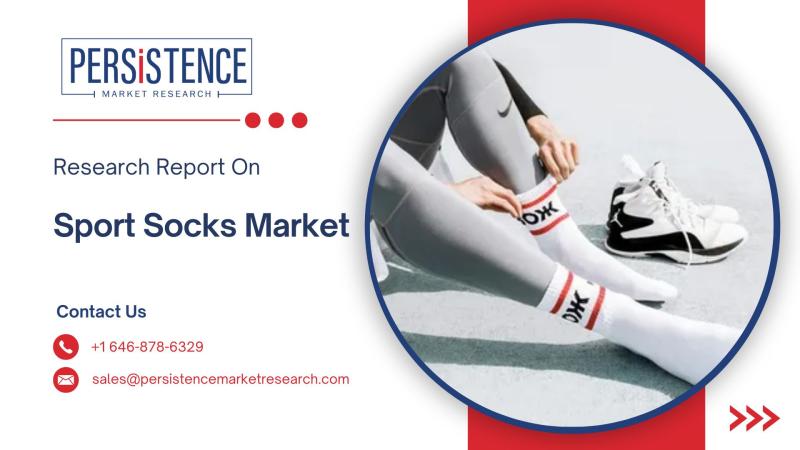

Sport Socks Market
The global sport socks market has been gaining significant traction due to the increasing demand for specialized athletic wear. With a focus on comfort, performance, and durability, sport socks are no longer a mere accessory but a critical component of athletes’ gear. The market for sport socks is thriving as consumers seek high-performance products that offer moisture-wicking properties, enhanced support, and breathability. This article delves into the key aspects of the market, from growth drivers to regional insights, to provide a comprehensive understanding of the sector.
✅ Overview of the Market and Key Growth Drivers
The sport socks market has witnessed a surge in popularity in recent years, driven by factors such as rising participation in sports and fitness activities, growing health-consciousness among consumers, and increasing awareness about the importance of specialized sportswear. Sport socks are designed to cater to various athletic activities, including running, cycling, basketball, and football, offering specific features like arch support, cushioning, and moisture control, which help to improve performance and prevent discomfort during physical activities.
Get a Sample Copy of Research Report (Use Corporate Mail id for Quick Response): https://www.persistencemarketresearch.com/samples/13975
The growing demand for customized and premium sportswear products has propelled the market forward. Consumers are increasingly looking for socks that are not only functional but also stylish, aligning with the broader trend of athleisure wear. Technological innovations in materials, such as the use of antimicrobial fabrics and advanced knitting techniques, have also contributed to the popularity of sport socks, as these innovations improve comfort and durability. Furthermore, the increasing penetration of e-commerce platforms and the availability of a wide range of sport socks online has expanded consumer access to these products, fostering market growth.
The athletic segment is one of the leading end-users in the sport socks market, driven by professional and amateur athletes who require high-quality socks to optimize their performance. Geographically, North America and Europe remain dominant players in the market due to the strong demand for sports apparel and the increasing focus on fitness. However, the Asia-Pacific region is expected to see the fastest growth, fueled by the rising popularity of fitness activities and sports in countries like China and India.
✅ Key Highlights from the Report:
➤ The sport socks market is growing due to increasing health and fitness awareness.
➤ Technological advancements in fabric and design are boosting product performance.
➤ E-commerce platforms are playing a significant role in expanding market reach.
➤ The athletic segment is the leading end-user category in the sport socks market.
➤ North America and Europe remain dominant in the global market.
➤ The Asia-Pacific region is expected to witness the fastest growth in the coming years.
📊 Market Segmentation
The sport socks market is divided into several key segments based on product type, end-users, and distribution channels, each catering to specific consumer needs and preferences.
Product Type: Sport socks come in various types, such as ankle socks, crew socks, knee-high socks, and compression socks, with each designed for different sports and activity levels. Ankle socks are preferred by runners and cyclists due to their lightweight and low-profile design, while compression socks are sought after by athletes who need improved blood circulation during or after physical activities. Crew socks and knee-high socks are typically worn for team sports like basketball, soccer, and football, providing additional support and protection to the legs and feet.
End-User Segmentation: The sport socks market primarily caters to professional athletes, amateur sports enthusiasts, and fitness-conscious individuals. The athlete segment remains the largest consumer group, as athletes require specialized socks to maximize performance and comfort during training and competition. On the other hand, the recreational segment, consisting of fitness enthusiasts and hobbyists, is growing rapidly due to the increasing trend of casual fitness activities and lifestyle changes. Additionally, the children’s segment is also expanding, driven by parents seeking performance-enhancing socks for their children involved in sports.
📊 Regional Insights
North America: North America continues to lead the sport socks market, driven by the high participation rate in sports and physical fitness activities. The presence of well-established sports apparel brands and a high standard of living contribute to the region’s dominance. In the United States, sports culture is deeply ingrained, with millions of people engaging in organized sports or personal fitness routines. This has led to a steady demand for high-performance sport socks, especially those from premium brands that offer advanced features like moisture-wicking, antimicrobial properties, and ergonomic designs.
Asia-Pacific: The Asia-Pacific region is experiencing the highest growth in the sport socks market. With rapidly growing economies and an increasing focus on health and fitness, countries like China, India, and Japan are witnessing a surge in demand for sport socks. As the fitness and sports culture becomes more embedded in these countries, especially among the younger population, the demand for functional and comfortable sport socks continues to rise. The increasing number of sports events, along with the expansion of fitness clubs and health centers, is also contributing to the growth of the sport socks market in this region.
Explore a wide range of in-depth market insights and detailed reports available on our website for further information and analysis: https://www.persistencemarketresearch.com/market-research/sport-socks-market.asp
✅ Market Drivers
Several key factors are fueling the growth of the sport socks market:
Increasing Health and Fitness Consciousness: As people become more aware of the benefits of regular exercise and sports, there has been a surge in the number of individuals participating in physical activities. Whether it’s running, cycling, or playing team sports, people are looking for specialized products like sport socks that enhance comfort and performance. This growing interest in fitness and wellness has been a significant driver for the sport socks market.
Technological Innovations in Sock Materials: One of the most important trends in the sport socks market is the incorporation of advanced technologies in the design and materials used for socks. For instance, moisture-wicking fabrics help keep the feet dry during intense workouts, while compression technology improves circulation and reduces fatigue. Innovations like antimicrobial treatments that prevent odors and improve hygiene are also contributing to the increasing demand for sport socks.
Rising Popularity of Athleisure: The athleisure trend, where athletic wear is worn as casual or everyday apparel, has expanded the consumer base for sport socks. People are now not only purchasing sport socks for their athletic activities but also for fashion purposes. This shift has created a broader market, with brands offering more stylish, performance-oriented socks suitable for both athletic and casual wear.
✅ Market Restraints
Despite the promising growth of the sport socks market, several challenges remain:
High Competition and Price Sensitivity: The sport socks market is highly competitive, with a large number of brands and retailers vying for market share. This intense competition often leads to price wars, which can affect profitability, especially for smaller players. Additionally, the price sensitivity of consumers, especially in developing regions, can hinder the growth of premium-priced sport socks.
Environmental Concerns: The growing concern over environmental sustainability is impacting the sport socks market, as consumers and manufacturers are increasingly looking for eco-friendly options. However, the production of performance socks using synthetic fibers like polyester and nylon can have a negative environmental impact. Companies need to balance performance with sustainability to meet the demands of environmentally-conscious consumers.
Limited Awareness in Developing Regions: While the sport socks market is growing in developed regions like North America and Europe, there is still limited awareness in some emerging markets. In regions where sports culture is still in its infancy, such as parts of Africa and Latin America, the demand for specialized sport socks may not be as high, slowing overall market growth.
✅ Market Opportunities
The sport socks market presents several promising opportunities for growth:
Emerging Markets: As sports culture continues to develop in emerging markets such as India, China, and Brazil, the demand for sport socks is expected to rise. These regions have large populations of young, active consumers who are increasingly participating in sports and fitness activities. Brands that can cater to the unique preferences of these markets stand to gain substantial market share.
Sustainability and Eco-Friendly Products: With rising environmental concerns, there is a growing opportunity for companies to tap into the demand for sustainable and eco-friendly sport socks. Using natural fibers such as organic cotton, bamboo, and recycled polyester can appeal to environmentally-conscious consumers. Brands that focus on creating green, sustainable products could differentiate themselves in the marketplace and gain a competitive edge.
E-Commerce Expansion: The continued growth of e-commerce offers an opportunity for brands to reach a global audience more efficiently. By leveraging online platforms, companies can expand their customer base, offer a wide range of sport socks, and benefit from the growing trend of online shopping. E-commerce allows for personalized shopping experiences and targeted marketing strategies that can boost sales and brand loyalty.
Do You Have Any Query Or Specific Requirement? Request Customization of Report: https://www.persistencemarketresearch.com/request-customization/13975
👉 Reasons to Buy the Report:
✔️ Comprehensive Market Insights: Gain in-depth knowledge of the sport socks market’s dynamics, trends, and growth prospects.
✔️ Regional Breakdown: Understand regional variations in demand and market opportunities, particularly in emerging markets.
✔️ Segmentation Analysis: Learn about the key segments within the sport socks market, including product types and end-users.
✔️ Competitive Landscape: Discover the key players and their strategies, helping you stay ahead of the competition.
✔️ Market Forecasts: Get accurate projections for the market’s growth and potential investment opportunities.
📌 Key Players
✦ Nike, Inc.
✦ Adidas AG
✦ Puma SE
✦ Under Armour, Inc.
✦ Reebok International Ltd.
■ In March 2023, Nike launched a new line of performance-enhancing sport socks made with sustainable materials.
■ In December 2022, Adidas partnered with a global sports retailer to expand its sport socks product line in Asia-Pacific.
The sport socks market is poised for significant growth, driven by innovations in technology, a growing fitness-conscious population, and emerging market opportunities. Companies that can balance performance with sustainability will be well-positioned for success in the evolving landscape of athletic wear.
☎️ Contact Us:
Persistence Market Research
G04 Golden Mile House, Clayponds Lane
Brentford, London, TW8 0GU UK
USA Phone: +1 646-878-6329
UK Phone: +44 203-837-5656
Email: sales@persistencemarketresearch.com
Web: https://www.persistencemarketresearch.com
About Persistence Market Research:
At Persistence Market Research, we specialize in creating research studies that serve as strategic tools for driving business growth. Established as a proprietary firm in 2012, we have evolved into a registered company in England and Wales in 2023 under the name Persistence Research & Consultancy Services Ltd. With a solid foundation, we have completed over 3600 custom and syndicate market research projects, and delivered more than 2700 projects for other leading market research companies’ clients.
Our approach combines traditional market research methods with modern tools to offer comprehensive research solutions. With a decade of experience, we pride ourselves on deriving actionable insights from data to help businesses stay ahead of the competition. Our client base spans multinational corporations, leading consulting firms, investment funds, and government departments. A significant portion of our sales comes from repeat clients, a testament to the value and trust we’ve built over the years.
This release was published on openPR.
Technology
Sports Officiating Technologies Market | Global Market Analysis Report
Sports Officiating Technologies Market Size and Share Forecast Outlook 2025 to 2035 The Sports Officiating Technologies Market is estimated to be valued at USD 3.8 billion in 2025 and is projected to reach USD 23.4 billion by 2035, registering a compound annual growth rate (CAGR) of 20.0% over the forecast period. Quick Stats for Sports […]

Sports Officiating Technologies Market Size and Share Forecast Outlook 2025 to 2035
The Sports Officiating Technologies Market is estimated to be valued at USD 3.8 billion in 2025 and is projected to reach USD 23.4 billion by 2035, registering a compound annual growth rate (CAGR) of 20.0% over the forecast period.
Quick Stats for Sports Officiating Technologies Market
- Sports Officiating Technologies Market Value (2025): USD 3.8 billion
- Sports Officiating Technologies Market Forecast Value (2035): USD 23.4 billion
- Sports Officiating Technologies Market Forecast CAGR: 20.0%
- Leading Segment in Sports Officiating Technologies Market in 2025: Video-based (34.0%)
- Key Growth Regions in Sports Officiating Technologies Market: North America, Asia-Pacific, Europe
- Top Key Players in Sports Officiating Technologies Market: Hawk-Eye Innovations, SMT (SportsMEDIA Technology), Catapult Sports, Zebra Technologies, Stats Perform, ChyronHego, PlaySight, Kinexon, Second Spectrum, ShotTracker
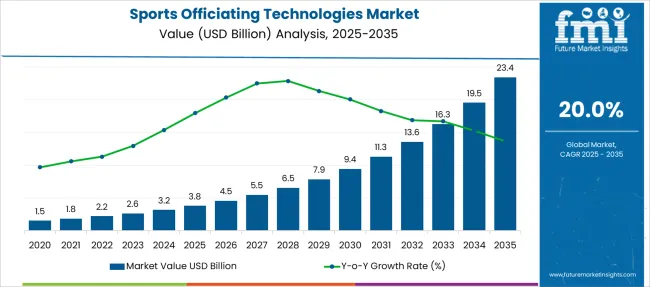
Sports Officiating Technologies Market Key Takeaways
| Metric | Value |
|---|---|
| Sports Officiating Technologies Market Estimated Value in (2025 E) | USD 3.8 billion |
| Sports Officiating Technologies Market Forecast Value in (2035 F) | USD 23.4 billion |
| Forecast CAGR (2025 to 2035) | 20.0% |
Why is the Sports Officiating Technologies Market Growing?
The Sports Officiating Technologies market is undergoing significant growth, supported by the rising demand for fairness, accuracy, and consistency in professional and amateur sports. Increasing global investment in competitive sports, along with the proliferation of broadcast partnerships and sponsorships, has elevated the need for transparent and technology-driven officiating systems. The integration of intelligent technologies into officiating processes is being driven by both governing bodies and fans, who expect real-time decision validation and error minimization.
Advances in video processing, data analytics, and sensor technologies have made it possible to implement precise adjudication systems across a wide variety of sports. Regulatory endorsements for technology-based officiating tools are further legitimizing adoption on a global scale.
The growing visibility of high-profile controversies and the reputational risks they pose have also prompted sports organizations to adopt advanced officiating platforms. As emerging technologies mature and stakeholder confidence increases, the market is expected to witness expanded implementation across new regions and sports categories, reinforcing long-term momentum..
Segmental Analysis
The market is segmented by Technology, Application, and Sports Type and region. By Technology, the market is divided into Video-based, High-speed cameras, Multi-angle camera systems, Slow-motion replay systems, Virtual Reality (VR) assisted review, Sensor-based, Wearable sensors, Equipment-embedded sensors, Court/field sensors, Acoustic sensors, Tracking, GPS-based tracking, RFID tracking, Optical tracking systems, Radar-based tracking, Communication, Wireless headsets, In-ear communication devices, Digital signaling systems, and Video conferencing.
In terms of Application, the market is classified into Decision review systems, Goal-line technology, Ball tracking, Video assistant referee (VAR), Challenge systems, Boundary detection, Automated line calling, Out-of-bounds detection, Touch detection, Timing and scoring, Electronic scoring systems, Precision timekeeping, Photo finish technology, Shot clocks and play clocks, Player/ball tracking, Position tracking, Speed and acceleration measurement, Distance covered analysis, Ball flight analysis, Foul detection, Contact detection, Handball detection, False start detection, Illegal motion detection, Equipment compliance, Automated equipment checks, Material composition analysis, and Size and weight verification.
Based on Sports Type, the market is segmented into Bat & ball sports, Ball sports, Racket sports, Racing sports, Track & field sports, Combat sports, and Other sports. Regionally, the market is classified into North America, Latin America, Western Europe, Eastern Europe, Balkan & Baltic Countries, Russia & Belarus, Central Asia, East Asia, South Asia & Pacific, and the Middle East & Africa.
Insights into the Video-based Technology Segment
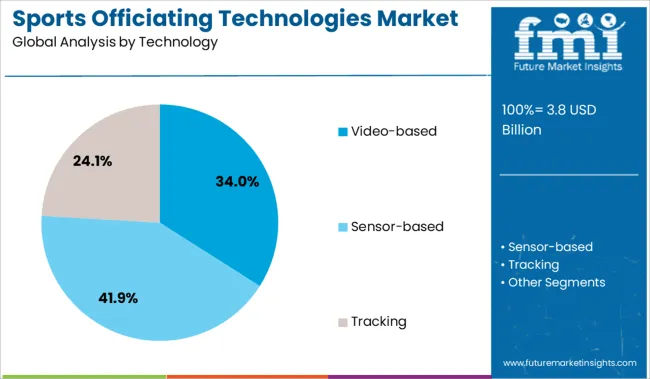
The video-based technology segment is projected to account for 34% of the Sports Officiating Technologies market revenue share in 2025, making it the dominant technology segment. This segment has gained traction due to its ability to deliver high-resolution visual evidence that aids in real-time and post-event decision making. The effectiveness of video replay systems in detecting on-field errors, clarifying contentious calls, and enhancing game integrity has driven widespread acceptance across leagues and tournaments.
Advancements in slow-motion capture, multi-angle feeds, and AI-assisted frame analysis have further improved accuracy and efficiency. The technology’s adaptability across diverse sports formats and its compatibility with existing broadcast infrastructure have contributed to its growth.
Adoption has also been encouraged by stakeholders’ focus on minimizing officiating disputes and boosting fan trust. As the demand for transparent and data-supported officiating continues to rise, video-based systems are expected to remain the preferred technological solution across global sporting platforms..
Insights into the Decision Review Systems Application Segment

The decision review systems segment is expected to contribute 30% of the Sports Officiating Technologies market revenue share in 2025, positioning it as the leading application segment. This growth has been supported by the critical role these systems play in validating or overturning referee and umpire decisions during high-stakes matches. As sports become increasingly competitive, the margin for error in officiating has narrowed, making accurate adjudication essential.
Decision review systems have been favored for their ability to reduce human error, support real-time feedback, and ensure procedural fairness. Their adoption has been reinforced by official rule changes in several sports leagues and governing bodies mandating their use for specific decisions.
Technological improvements such as real-time analytics, automated tracking, and enhanced user interfaces have increased system reliability and operator efficiency. As public scrutiny and media coverage intensify, the utility of decision review systems in maintaining credibility and game integrity is expected to sustain their leadership position within the application segment..
Insights into the Bat and Ball Sports Sports Type Segment
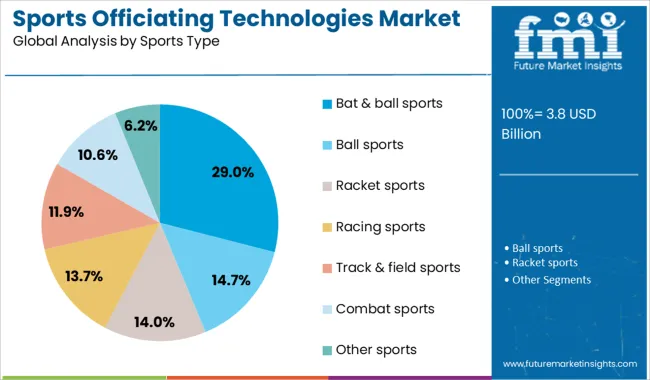
The bat and ball sports segment is anticipated to account for 29% of the Sports Officiating Technologies market revenue share in 2025, making it the largest sports type segment. The adoption of officiating technologies in this category has been driven by the high reliance on precise judgment in events such as boundary calls, wicket decisions, and pitch tracking. The complexity and speed of gameplay in bat and ball sports have necessitated the use of accurate decision-support systems to supplement umpire rulings.
Stakeholder investment in preserving the competitive integrity of these sports has led to early and extensive integration of technologies such as video reviews, tracking software, and automated alerts. Broadcast partners and sponsors have also supported adoption, as technology-backed officiating enhances viewer engagement and credibility.
As international tournaments and leagues expand, governing bodies are increasingly mandating uniform implementation of technology to standardize decision making. This has reinforced the dominant position of bat and ball sports in driving the overall market growth..
What are the Drivers, Restraints, and Key Trends of the Sports Officiating Technologies Market?
Sports leagues are adopting AI-driven officiating tools to enhance decision accuracy and reduce human error. Rising media, betting, and sponsorship pressures are driving integration of replay tech with broadcasts for transparency and monetization.
Growing Adoption of Data-Driven Decision-Making in Sports
The demand for real-time, data-supported officiating is fueling adoption of technologies like VAR (Video Assistant Referee), Hawk-Eye, and sensor-integrated wearables across multiple sports. Leagues and federations are increasingly relying on objective evidence to reduce human error and uphold fairness, especially in high-stakes matches. Advanced analytics and frame-by-frame video analysis are being embedded into referee training systems. Increased use of AI-based playback systems is also improving officiating accuracy, particularly in tennis, soccer, and cricket. As sports organizations compete for credibility and viewer trust, data-backed decision tools are becoming foundational to regulatory structures and league operations across national and international levels.
Commercial Pressures and Broadcast Integration
The rising financial stakes in professional sports, from media rights to fan engagement, have turned officiating accuracy into a business imperative. Broadcasters are leveraging officiating tech feeds to enhance viewer experience, while leagues are integrating these systems to protect the integrity of game outcomes. High-definition replay systems and multi-angle feeds are increasingly synchronized with live broadcasting. Pressure from teams, sponsors, and betting stakeholders to ensure transparent decisions is accelerating adoption. Moreover, league partnerships with tech providers for exclusive officiating solutions are becoming standard, creating new revenue channels and standardizing technologies across tournaments to ensure consistency and monetization potential.
Analysis of Sports Officiating Technologies Market By Key Countries
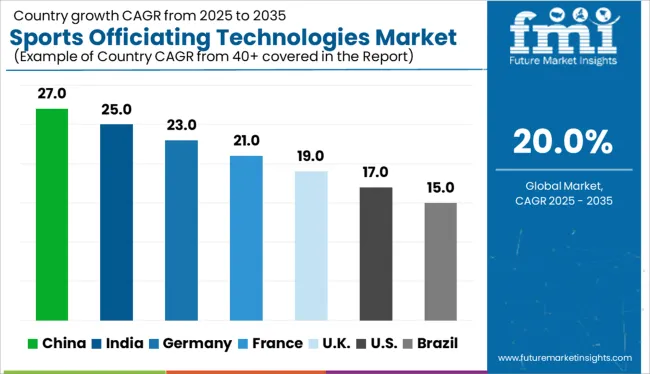
| Country | CAGR |
|---|---|
| India | 25.0% |
| Germany | 23.0% |
| France | 21.0% |
| UK | 19.0% |
| USA | 17.0% |
| Brazil | 15.0% |
The global sports officiating technologies market is projected to expand at a CAGR of 20% from 2025 to 2035, driven by heightened demand for fairness, accuracy, and fan engagement across professional and amateur sports. Among BRICS countries, China (27.0%) and India (25.0%) are outperforming the global average due to rapid digitization in sports infrastructure and increased adoption of VAR, AI-based analytics, and sensor technologies in national leagues and grassroots tournaments. This growth is amplified by governmental support to professionalize sports ecosystems and attract international sporting events. Germany (23.0%), as part of the OECD, leads Europe’s technological transformation in officiating, leveraging innovations in precision tracking and real-time analytics across football, athletics, and motorsports. The UK (19.0%) and US (17.0%), though significant players, are slightly below the global average due to legacy systems and differing levels of tech standardization across leagues. ASEAN markets are witnessing a rising trend of officiating tech integration, especially in e-sports and emerging regional tournaments, representing untapped potential.
Market Dynamics of Sports Officiating Technologies in the United Kingdom
The CAGR for the UK sports officiating technologies market was approximately 3.4% during 2020–2024, reflecting limited early-stage investment in officiating tools across lower-tier leagues and resistance from traditional sporting bodies. Based on the 2024 market value of USD 19.0 million and aligning with the global CAGR of 20%, the CAGR for 2020–2024 calculates to around 3.4%, rising sharply to 9.6% from 2025–2035. This upward trajectory is driven by the Football Association and Premier League’s intensified focus on real-time video analytics and referee-assist systems post-2024. Post-Brexit tech partnerships encouraged domestic procurement of officiating tools, while broadcast deals prioritized replay-integrated match coverage. Further, grassroots and amateur leagues started piloting low-cost digital officiating tools via federated funding programs to enhance referee training and performance transparency.
- Hawk-Eye installations expanded across all EPL venues by 2026.
- Grassroots leagues increased officiating tech trials by 3× between 2025 and 2028.
- UK-based suppliers formed 9 broadcast-tech integrations by 2027.
Growth Analysis of Sports Officiating Technologies in the United States
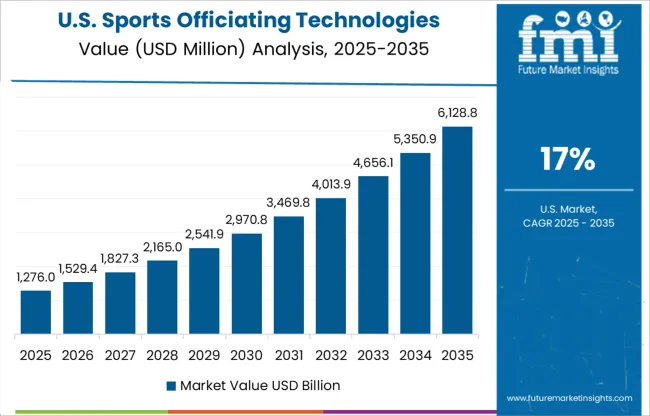
The CAGR of the sports officiating technologies market in the United States was around 4.2% during 2020–2024, limited by fragmented sporting regulations across leagues. From a 2024 value of USD 17.0 million, the CAGR is projected to rise to 8.4% for 2025–2035, fueled by increased pressure from sports betting entities and broadcaster partnerships to minimize human error. NFL and MLB expanded video-assist frameworks, while collegiate leagues piloted automated umpire systems integrated with AI and ball-tracking data. Major sports universities started adopting motion analytics for officiating education. The post-2025 digital transformation of fan engagement, featuring alternate feeds with referee communication, pushed federations to invest in transparency-enhancing technologies.
- NFL’s AI-assisted call reviews expanded to 31 teams by 2027.
- NCAA adopted officiating training systems in 52 universities by 2028.
- Referee mic systems became standard across televised events by 2026.
Opportunity Analysis of Sports Officiating Technologies in Germany
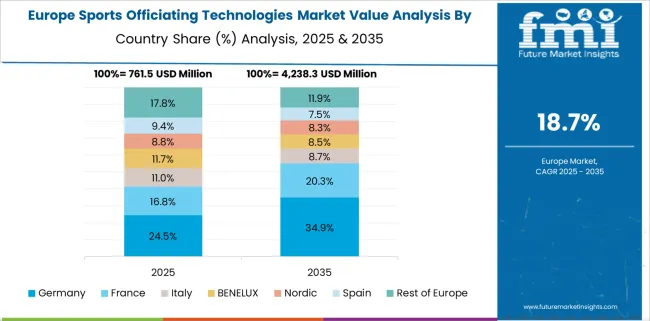
Germany’s sports officiating technologies market grew at a 5.1% CAGR from 2020–2024, with adoption limited mostly to Bundesliga-level football. The CAGR is expected to rise to 10.1% for 2025–2035, driven by structured national policies integrating officiating technology into training programs for referees across handball, basketball, and football. Public funding support for federations and high-definition broadcast enhancements by ARD and ZDF also stimulated investments. The German Olympic Sports Confederation pushed for tech standardization, enabling small-to-mid-tier leagues to access bundled replay and motion detection solutions. A rising domestic ecosystem of officiating system developers further enabled scalable and compliant deployment across regional leagues.
- National handball league integrated instant-replay systems in 2026.
- 61% of televised football matches used multi-angle VAR by 2028.
- Germany hosted the first European Officiating Tech Expo in 2025.
Demand Outlook for Sports Officiating Technologies in China
China’s sports officiating technologies market registered a CAGR of 6.3% from 2020–2024, aided by its centralized investments in professional sports infrastructure. The CAGR is expected to accelerate to 12.8% between 2025 and 2035, supported by large-scale national programs for smart stadiums and digital refereeing tools. China’s Football Association mandated AI-assisted line calls and instant replay from 2026 across top-tier matches. High school and university leagues also began piloting referee training tools using motion sensors and augmented reality. Cross-border partnerships with Korean and Japanese tech providers strengthened the hardware and software supply chains. China’s goal to digitize all Tier 1 matches by 2030 is propelling consistent investment.
- Smart referee kits deployed in 17 provinces by 2027./li>
- AI-based foul detection tested in basketball leagues in 2026.
- Tier 1 league compliance with replay standards reached 93% by 2029.
Sales Trends of Sports Officiating Technologies in India
India’s sports officiating technologies market grew at a CAGR of 5.5% during 2020–2024, with adoption primarily centered on cricket. This is expected to rise to 10.6% for 2025–2035, driven by the IPL and Pro Kabaddi League’s adoption of ultra-motion replay systems and third umpire automation. State governments, under Khelo India, began integrating digital officiating tools in school-level tournaments, encouraging widespread familiarity. Rising viewership and monetization potential through OTT platforms such as Hotstar and JioCinema led to integration of referee-audio, real-time foul analysis, and multiple camera angles in live streams. Indian startups, supported by government incubation, began exporting officiating modules to ASEAN countries post-2026.
- IPL’s officiating tech budget grew 2.7× between 2024 and 2027.
- Kabaddi leagues added motion-triggered sensors in 2026.
- 63% of national sports events adopted video-review systems by 2029.
Competitive Landscape of Sports Officiating Technologies Market
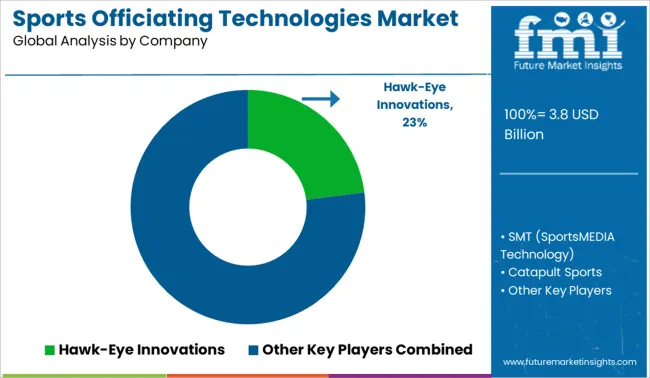
In the sports officiating technologies market, key players are revolutionizing the accuracy and transparency of sports through AI, real-time data, and motion-tracking systems. Companies like Hawk-Eye Innovations, SMT (SportsMEDIA Technology), and Catapult Sports are deploying ball-tracking, replay validation, and referee-assist systems across tennis, football, and basketball. Zebra Technologies and Stats Perform are enhancing game intelligence by integrating RFID and predictive analytics into officiating workflows. ChyronHego and PlaySight are equipping venues with multi-angle replay systems to support broadcast-integrated decision-making, while Kinexon, Second Spectrum, and ShotTracker focus on player-positioning tech to aid foul detection and movement-based rulings. These solutions are widely adopted by leagues such as the NBA, EPL, and ATP, ensuring consistency, integrity, and commercial value in sports governance.
Scope of the Report
| Item | Value |
|---|---|
| Quantitative Units | USD 3.8 Billion |
| Technology | Video-based, High-speed cameras, Multi-angle camera systems, Slow-motion replay systems, Virtual Reality (VR) assisted review, Sensor-based, Wearable sensors, Equipment-embedded sensors, Court/field sensors, Acoustic sensors, Tracking, GPS-based tracking, RFID tracking, Optical tracking systems, Radar-based tracking, Communication, Wireless headsets, In-ear communication devices, Digital signaling systems, and Video conferencing |
| Application | Decision review systems, Goal-line technology, Ball tracking, Video assistant referee (VAR), Challenge systems, Boundary detection, Automated line calling, Out-of-bounds detection, Touch detection, Timing and scoring, Electronic scoring systems, Precision timekeeping, Photo finish technology, Shot clocks and play clocks, Player/ball tracking, Position tracking, Speed and acceleration measurement, Distance covered analysis, Ball flight analysis, Foul detection, Contact detection, Handball detection, False start detection, Illegal motion detection, Equipment compliance, Automated equipment checks, Material composition analysis, and Size and weight verification |
| Sports Type | Bat & ball sports, Ball sports, Racket sports, Racing sports, Track & field sports, Combat sports, and Other sports |
| Regions Covered | North America, Europe, Asia-Pacific, Latin America, Middle East & Africa |
| Country Covered | United States, Canada, Germany, France, United Kingdom, China, Japan, India, Brazil, South Africa |
| Key Companies Profiled | Hawk-Eye Innovations, SMT (SportsMEDIA Technology), Catapult Sports, Zebra Technologies, Stats Perform, ChyronHego, PlaySight, Kinexon, Second Spectrum, and ShotTracker |
| Additional Attributes | Dollar sales, share by sport type, league adoption rates, regulatory mandates, broadcaster partnerships, pricing benchmarks, regional growth hotspots, and tech integration trends. |
Technology
The POVA 7 Ultra 5G is arriving soon
AI-driven innovative technology brand TECNO is bringing to Filipino youth its culture defining tech style icon, the POVA 7 Ultra 5G on August 8. Bold, sleek and minimalist with pure interstellar spaceship design and hyper gaming engine for elite esports, the POVA 7 Ultra 5G is trusted by champions to push limits. As the official […]

AI-driven innovative technology brand TECNO is bringing to Filipino youth its culture defining tech style icon, the POVA 7 Ultra 5G on August 8. Bold, sleek and minimalist with pure interstellar spaceship design and hyper gaming engine for elite esports, the POVA 7 Ultra 5G is trusted by champions to push limits.
As the official gaming phone of Philippine national esports team SIBOL, the POVA 7 Ultra 5G is the perfect power partner for SIBOL to dominate the global gaming arena at the Southeast Asian Games and World Esports Games.

From galaxy to your grip – lighting up your world, dancing to your life
The POVA 7 Ultra 5G will capture the imagination of a new generation of edgy and futuristic users with its full customization capability – distinctive appearance and iconic styling designed to delight. Generic phones will be a thing of the past for the Filipino youth with this ultra stylish smartphone.


The POVA 7 Ultra 5G redefines trendy tech art with its “Line & Lighting” theme, featuring upgraded 104 mini-LEDs surrounding the camera for the innovative “Status Light,” enabling customizable lighting patterns for notifications and enhancing both style and functionality.


Beyond visual distinction, the POVA 7 Ultra 5G excels in performance, offering a full suite of AI-powered tools supported by a high-performance chipset and robust battery. It is truly a symbol of TECNO’s dedication to continuing its mission of empowering next generation users with trend-tech styles and advanced technology.
Get it first on TikTok Super Brand Day on 8.8
Be among the first to own the POVA 7 Ultra 5G during its first launch on TikTok on Super Brand Day. Running from Aug 8 to Aug 14, customers who purchase the new smartphone will get freebies worth up to PhP1,999 – buy 1 get 1 POVA wireless powerbank + 1 Customised Dito UNLI PUBG Prepaid Gaming SIM card + 1 Special Edition PUBGM case card.
Experience POVA 7 Ultra 5G’s superpower at the POVA Gaming Fiesta
Make your way to SM Fairview on August 9 to experience firsthand POVA 7 Ultra 5G’s futuristic features and powerful performance. Immerse yourself in esport games like never before and feel the difference when you outperform opponents and light up your wins in celebration.
Meet and greet the gamechangers and trendsetters, starting with POVA 7 Ultra 5G’s Chief Gaming Officer. Take front row seats and watch a top gamer Showmatch. See why SIBOL picked POVA 7 Ultra 5G as its official gaming phone, and TECNO Mobile Philippines as its official smartphone partner.
Similar to TECNO’s mantra, SIBOL will “Stop At Nothing” in its quest to bring honor to the Philippines in the esports arena. Game on!
ADVT.
This article is brought to you by Tecno Mobile.
Technology
Fantasy Sports Market Set Size to Hit $67.03B by 2033: Insights & Trends
Market Size & Growth Market Size (2024): USD 28.95 Billion Projected Market Size (2033): USD 67.03 Billion Compound Annual Growth Rate (CAGR) (2025-2033): 9.29% Key Market Drivers Explosive Fan Engagement and Sports Enthusiasm Surge in Mobile Access and Real-Time Technology Favorable Government Policies and New Regulatory Clarity Emerging Trends Daily Fantasy and Micro-Contests Take Center […]

Market Size & Growth
- Market Size (2024): USD 28.95 Billion
- Projected Market Size (2033): USD 67.03 Billion
- Compound Annual Growth Rate (CAGR) (2025-2033): 9.29%
Key Market Drivers
- Explosive Fan Engagement and Sports Enthusiasm
- Surge in Mobile Access and Real-Time Technology
- Favorable Government Policies and New Regulatory Clarity
Emerging Trends
- Daily Fantasy and Micro-Contests Take Center Stage
- Technology Integration: AI, Blockchain, and Analytics
- Growth of Esports and Diversification Beyond Traditional Sports
Segmentation Highlights
- Analysis by Sports Type
- Analysis by Platform
- Analysis by Demographics
- Regional Analysis
Market Overview:
According to IMARC Group’s latest research publication, the global fantasy sports industry size wasvalued at USD 28.95 Billion in 2024. Looking forward, IMARC Group estimates the market to reach USD 67.03 Billion by 2033, exhibiting a CAGR of 9.29% during 2025-2033.
This detailed analysis primarily encompasses industry size, business trends, market share, key growth factors, and regional forecasts. The report offers a comprehensive overview and integrates research findings, market assessments, and data from different sources. It also includes pivotal market dynamics like drivers and challenges, while also highlighting growth opportunities, financial insights, technological improvements, emerging trends, and innovations. Besides this, the report provides regional market evaluation, along with a competitive landscape analysis.
Grab a sample PDF of this report: https://www.imarcgroup.com/fantasy-sports-market/requestsample
Our report includes:
- Market Dynamics
- Market Trends and Market Outlook
- Competitive Analysis
- Industry Segmentation
- Strategic Recommendations
Growth Factors in the Fantasy Sports Market
- Explosive Fan Engagement and Sports Enthusiasm
What’s really pushing the fantasy sports industry forward is a passionate and ever-expanding global sports fan base. Football, cricket, basketball, and baseball consistently attract millions of die-hard fans who don’t just watch games—they want to participate, compete, and connect. Fantasy platforms allow fans to build virtual teams and test their sports IQ, making them feel part of the action. Millions of users drive platform engagement, with the team sports segment alone capturing over a third of industry revenues. Platforms routinely report user participation in the tens of millions, and as awareness and sporting events increase worldwide, so does participation. In particular, football fantasy leagues leverage massive followings of the English Premier League, La Liga, and large tournaments, which keeps fans engaged year-round through an interactive, gamified environment that rewards sporting knowledge and strategy.
- Surge in Mobile Access and Real-Time Technology
The surge of smartphone adoption and high-speed internet access has made fantasy sports far more accessible. Today, almost every fantasy sports user plays on a mobile device—they’re checking scores, adjusting teams, and interacting with friends from anywhere, anytime. Mobile and online platforms dominate, accounting for the largest share of the market’s total value, and real-time data integration is now the standard. This seamless access is further boosted by tech innovations like live analytics, AI-driven recommendations, and blockchain-backed security and payments. Monetization tools—such as in-app purchases, sponsorships, and advertising—are enabled by this ecosystem. For example, app launches and new platform features regularly drive spikes in sign-ups and engagement, and the integration of virtual reality and secure payments has become a differentiator for leading brands like DraftKings, FanDuel, and Dream Sports.
- Favorable Government Policies and New Regulatory Clarity
Supportive government regulations have paved the way for industry growth, especially in North America and parts of Europe. For instance, several U.S. states have implemented specific consumer protection laws—like the Fantasy Sports Consumer Protection Act in Rhode Island—which clarify rules for operators, enable safe transactions, and protect users with age-verification and responsible gaming policies. These frameworks help legitimize the industry, attract investment, and encourage platform innovation. Legal certainty also allows companies to advertise openly and partner with professional sports leagues. In places where fantasy sports are classified separately from gambling, platforms experience faster growth due to lower compliance barriers and new tax revenue streams for governments. These government-backed moves ensure a safer, more sustainable, and thriving marketplace for millions of global players and stakeholders.
Key Trends in the Fantasy Sports Market
- Daily Fantasy and Micro-Contests Take Center Stage
Short-format fantasy games—known as Daily Fantasy Sports (DFS) and micro-contests—have exploded in popularity. Unlike traditional season-long leagues, DFS offers instant gratification, daily or weekly payouts, and flexible contest types. Platforms allow users to draft fresh lineups every day, catering to sports fans who crave regular engagement. Major brands like FanDuel and DraftKings now generate a significant chunk of revenue from these formats, with some operators reporting that daily and weekly contest participation accounts for over half of their total active user base. This trend has also broadened the fantasy experience, attracting fans who might not have the patience for season-long commitment. The rise of DFS is closely tied to legal sports betting and has reshaped both online sports engagement and the broader entertainment landscape.
- Technology Integration: AI, Blockchain, and Analytics
Fantasy sports platforms are racing to embed the latest tech innovations—and users are loving it. Artificial intelligence now powers personalized team suggestions, predictive analytics, and even customer support chatbots, creating a tailored and engaging experience that helps players gain an edge over rivals. Blockchain is emerging as a powerful tool for transparency, enabling provably fair gaming and new monetization streams such as NFT-based fantasy trading and digital collectibles. Real-time analytics are widely used: from tracking player stats to injury alerts, users can access a wealth of data before making lineup decisions. These tech-forward features boost player retention, foster trust, and differentiate brands in a crowded market. Many leading platforms now attract not just sports fans but also data enthusiasts and crypto-savvy users seeking next-gen interactivity.
- Growth of Esports and Diversification Beyond Traditional Sports
As esports competitions soar in popularity, fantasy sports platforms have moved quickly to include video gaming alongside traditional sports. Fantasy contests for games like League of Legends, Dota 2, and Counter-Strike are now commonplace, appealing to a huge global community of younger digital natives who follow competitive gaming as closely as any mainstream sport. Sports portfolio diversification doesn’t stop there: fantasy cricket, extreme sports, and even niche leagues are drawing new demographics into the fold. This diversification is key—platforms report rapid growth in regions like Asia-Pacific, driven by rising esports and cricket fandom. By embracing this cultural shift and offering contests across a wide range of sports, companies tap into untapped demand, bring fresh excitement to the ecosystem, and future-proof against changing consumer tastes and media trends.
Buy Full Report: https://www.imarcgroup.com/checkout?id=6531&method=1670
Leading Companies Operating in the Global Fantasy Sports Industry:
- Apollo Global Management Inc.
- CBS Sports Network (CBS Broadcasting, Inc.)
- Dream Sports Inc.
- Fantasy Power 11
- FantasyPros
- Fantrax
- Flutter Entertainment plc
- Fsport
- Galactus Funware Technology Private Limited
- Gameskraft Technologies
- RealTime Fantasy Sports Inc.
- RotoBash
- Sachar Gaming Private Limited
Fantasy Sports Market Report Segmentation:
By Sports Type:
- Football
- Baseball
- Basketball
- Hockey
- Cricket
- Others
Football dominates the fantasy sports market due to its massive fan base, particularly in North America and Europe, with a seasonal format that aligns well with fantasy sports’ competitive structure, enhanced by detailed player statistics and extensive media coverage.
By Platform:
- Website
- Mobile Application
Mobile Application leads the market with around 55.0% market share in 2024, dominating due to convenience, accessibility, and user-friendly interfaces, alongside advancements in app technology that enhance user engagement.
By Demographics:
- Under 25 Years
- 25-40 Years
- Above 40 Years
25 to 40 Years leads the market with around 29.8% market share in 2024, characterized by tech-savviness, disposable income, and active participation in sports discussions and competitions.
Regional Insights:
- North America (United States, Canada)
- Asia Pacific (China, Japan, India, South Korea, Australia, Indonesia, Others)
- Europe (Germany, France, United Kingdom, Italy, Spain, Russia, Others)
- Latin America (Brazil, Mexico, Others)
- Middle East and Africa
North America Accounted for the largest market share of over 35.0% in 2024, driven by a deep-rooted sports culture, widespread league popularity, high internet penetration, and the integration of real-time analytics and gamified experiences.
Research Methodology:
The report employs a comprehensive research methodology, combining primary and secondary data sources to validate findings. It includes market assessments, surveys, expert opinions, and data triangulation techniques to ensure accuracy and reliability.
Note: If you require specific details, data, or insights that are not currently included in the scope of this report, we are happy to accommodate your request. As part of our customization service, we will gather and provide the additional information you need, tailored to your specific requirements. Please let us know your exact needs, and we will ensure the report is updated accordingly to meet your expectations.
About Us:
IMARC Group is a global management consulting firm that helps the world’s most ambitious changemakers to create a lasting impact. The company provide a comprehensive suite of market entry and expansion services. IMARC offerings include thorough market assessment, feasibility studies, company incorporation assistance, factory setup support, regulatory approvals and licensing navigation, branding, marketing and sales strategies, competitive landscape and benchmarking analyses, pricing and cost research, and procurement research.
Contact Us:
IMARC Group
134 N 4th St. Brooklyn, NY 11249, USA
Email: [email protected]
Tel No:(D) +91 120 433 0800
United States: +1-201971-6302
Technology
Payment Labs Sports Partnerships Expand with Paul Brewer
Payment Labs Sports Partnerships gain momentum with the appointment of Paul Brewer as Executive VP of Sales & Sports Partnerships. A veteran of esports and traditional sports, Brewer will lead the company’s expansion in sports payment infrastructure—especially in NIL and athlete-focused sectors. “With the rapidly evolving NIL landscape, a new generation of athlete entrepreneurs, and […]

Payment Labs Sports Partnerships gain momentum with the appointment of Paul Brewer as Executive VP of Sales & Sports Partnerships. A veteran of esports and traditional sports, Brewer will lead the company’s expansion in sports payment infrastructure—especially in NIL and athlete-focused sectors.
“With the rapidly evolving NIL landscape, a new generation of athlete entrepreneurs, and new innovative league prize formats, there’s a growing need for a fast, reliable, and compliant payment infrastructure,” said Brewer. “Payment Labs’ proprietary platform delivers a solution at scale. I’m looking forward to working with the team to bring this innovative technology to more partners to help them operate with the efficiency the modern sports landscape demands.”
Brewer brings more than two decades of traditional sports and emerging industry experience across a range of media companies, brands, and properties. This includes partnering with the NBA, the NHL and Coca-Cola at marketing tech platform Rival and increasing sponsorship revenue at the world’s largest esports company ESL by over 850 percent. He also led sales development and marketing strategy across Turner Broadcasting’s digital sports properties, including Bleacher Report, NBA, NCAA, PGA, and NASCAR.
“Paul’s background in sports and esports gives him a unique perspective on the complexities organizations have to navigate when it comes to their payment needs of sports,” said Han Park, CEO, Payment Labs. “His decision to join Payment Labs further validates our capabilities within the sports industry, and his knowledge will be invaluable as we bring our platform to more emerging and established sports companies that need a better way to manage complicated payments.”
Brewer’s appointment comes as many sports organizations rely on antiquated software and cumbersome processes for managing global payouts to athletes, vendors, and creators. Payment Labs directly addresses these pain points with its vertically integrated, purpose-built tech stack that replaces manual workflows with a streamlined and compliant solution.
Armed with Brewer’s market-leading expertise, Payment Labs is well equipped to solidify its position as an essential partner for forward-thinking sports properties. This includes up-and-coming sports leagues, organized youth sports, collegiate athletics, professional teams, and more. The company is already trusted by X Games, The Snow League, Arnold Sports, AVP, APP, PDGA, and more, demonstrating its relevance and capabilities beyond its origins in competitive gaming.
With Paul Brewer at the helm, Payment Labs Sports Partnerships will deliver streamlined payout solutions for emerging leagues, athlete entrepreneurs, and youth sports. For more information on Payment Labs, please visit paymentlabs.io.
-

 Fashion3 weeks ago
Fashion3 weeks agoEA Sports College Football 26 review – They got us in the first half, not gonna lie
-

 Health3 weeks ago
Health3 weeks agoCAREGD Trademark Hits the Streets for Mental Health Month
-

 Sports3 weeks ago
Sports3 weeks agoNew NCAA historical database provides wealth of information on championships
-

 Sports2 weeks ago
Sports2 weeks agoVolleyball Releases 2025 Schedule – Niagara University Athletics
-

 Sports2 weeks ago
Sports2 weeks agoAdapti, Inc. (OTC
-

 College Sports3 weeks ago
College Sports3 weeks agoBuford DB Tyriq Green Commits to Georgia
-

 High School Sports1 week ago
High School Sports1 week ago100 days to men's college basketball
-

 Rec Sports2 weeks ago
Rec Sports2 weeks agoFlorida woman, 20, accused of pepper-spraying rich men in Miami Beach hotels, stealing their luxury watches
-

 Health2 weeks ago
Health2 weeks agoJoliet West alum's basketball clinic focuses on mental health as well as physical performance
-

 Youtube3 weeks ago
Youtube3 weeks agoHawaii TOP SPORTS MOMENTS! 🏈⚾ | SportsCenter





























